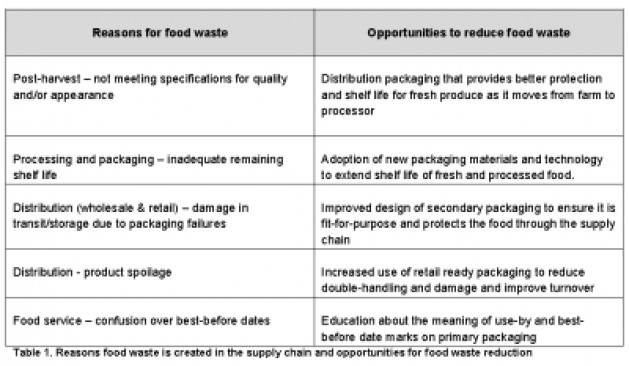New research shows packaging has a vital role to play within the supply chain in minimising food waste.
Conducted by RMITUniversity’s Centre for Design and commissioned by CHEP Australia, the study shows where – and why – food waste occurs along both the fresh and manufactured food supply chains and proposes opportunities for industry to address it through innovative and sustainable primary, secondary and tertiary packaging (See Table 1).
RMIT Senior Research Fellow Dr Karli Verghese led the research study, titled The role of packaging in minimising food waste in the supply chain of the future.
The study addresses a knowledge gap identified by the Australian Food and Grocery Council’s Future of Packaging white paper (RMITUniversity, April 2012) regarding understanding food waste to inform product and packaging design, and focuses on the commercial and industrial food supply chain.
Dr Verghese said: “Food security is an emerging challenge for both policy makers and companies in the fresh and manufactured food supply chains, however, no significant research had previously been conducted into the role that packaging plays in minimising food waste in Australia.
“Packaging actually plays a critical role in protecting fresh produce and processed food in transit, in storage, at point of sale and prior to consumption. In doing so it helps deliver a wide range of functions while reducing food waste.”
While households are the largest generator of food waste to landfill (2.7 million tonnes each year), the report shows that in the commercial and industrial sector the largest generators are food services (661,000 tonnes), followed by food manufacturing (312,000 tonnes), retailing (179,000 tonnes) and wholesale distribution (83,000 tonnes). However, food waste recovery rates are extremely high in the manufacturing sector, with 90 per cent of waste repurposed.
Dr Verghese said: “While some food waste in the supply chain is inevitable – for example, trimmings from fresh produce and preparation waste in manufacturing and food services – other waste is avoidable.
“Our research identified opportunities for improvement where food waste is incurred through things like poor inventory management, overstocking of shelves, or product damage during transport and handling.
“There are certainly opportunities to minimise food waste through packaging innovation and design, such as improved ventilation and temperature control for fresh produce, and better understanding the dynamics between different levels of packaging, to ensure they are designed fit-for-purpose.”
President of CHEP Australia & New Zealand, Phillip Austin said: “We all have a role to play in addressing food loss and food waste.
“As a partner in many food supply chains, and a leader in reusable packaging with an inherently sustainable business model, CHEP wants to be part of the solution and we would welcome opportunities to work with industry to create even more sustainable packaging solutions.”






